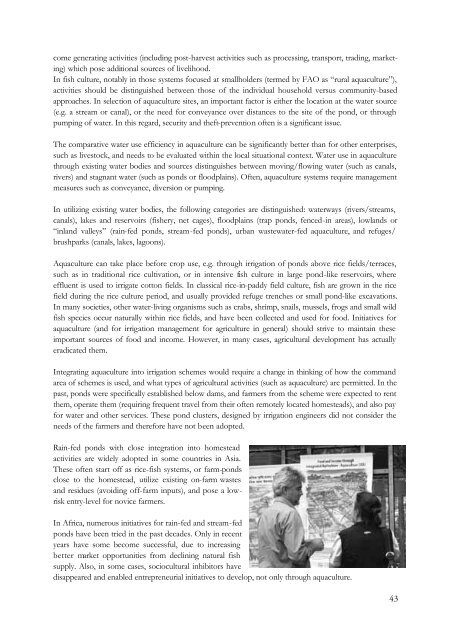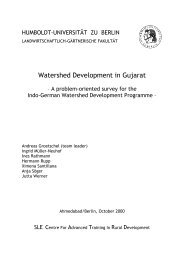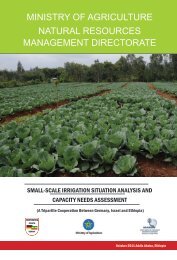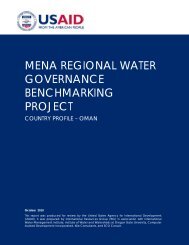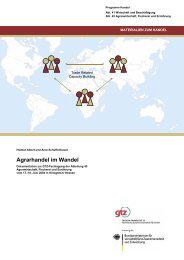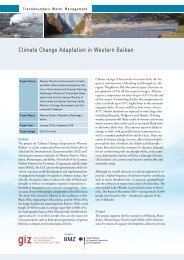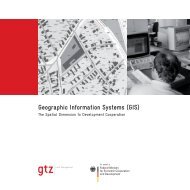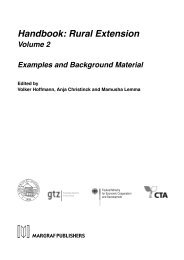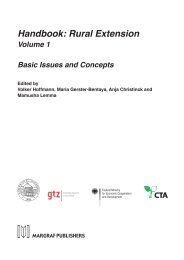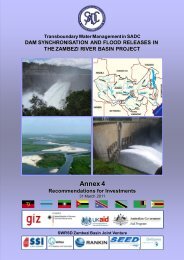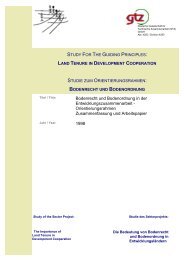Wasser in der Landwirtschaft - agriwaterpedia.info
Wasser in der Landwirtschaft - agriwaterpedia.info
Wasser in der Landwirtschaft - agriwaterpedia.info
Sie wollen auch ein ePaper? Erhöhen Sie die Reichweite Ihrer Titel.
YUMPU macht aus Druck-PDFs automatisch weboptimierte ePaper, die Google liebt.
come generat<strong>in</strong>g activities (<strong>in</strong>clud<strong>in</strong>g post-harvest activities such as process<strong>in</strong>g, transport, trad<strong>in</strong>g, market<strong>in</strong>g)<br />
which pose additional sources of livelihood.<br />
In fish culture, notably <strong>in</strong> those systems focused at smallhol<strong>der</strong>s (termed by FAO as “rural aquaculture”),<br />
activities should be dist<strong>in</strong>guished between those of the <strong>in</strong>dividual household versus community-based<br />
approaches. In selection of aquaculture sites, an important factor is either the location at the water source<br />
(e.g. a stream or canal), or the need for conveyance over distances to the site of the pond, or through<br />
pump<strong>in</strong>g of water. In this regard, security and theft-prevention often is a significant issue.<br />
The comparative water use efficiency <strong>in</strong> aquaculture can be significantly better than for other enterprises,<br />
such as livestock, and needs to be evaluated with<strong>in</strong> the local situational context. Water use <strong>in</strong> aquaculture<br />
through exist<strong>in</strong>g water bodies and sources dist<strong>in</strong>guishes between mov<strong>in</strong>g/flow<strong>in</strong>g water (such as canals,<br />
rivers) and stagnant water (such as ponds or floodpla<strong>in</strong>s). Often, aquaculture systems require management<br />
measures such as conveyance, diversion or pump<strong>in</strong>g.<br />
In utiliz<strong>in</strong>g exist<strong>in</strong>g water bodies, the follow<strong>in</strong>g categories are dist<strong>in</strong>guished: waterways (rivers/streams,<br />
canals), lakes and reservoirs (fishery, net cages), floodpla<strong>in</strong>s (trap ponds, fenced-<strong>in</strong> areas), lowlands or<br />
“<strong>in</strong>land valleys” (ra<strong>in</strong>-fed ponds, stream-fed ponds), urban wastewater-fed aquaculture, and refuges/<br />
brushparks (canals, lakes, lagoons).<br />
Aquaculture can take place before crop use, e.g. through irrigation of ponds above rice fields/terraces,<br />
such as <strong>in</strong> traditional rice cultivation, or <strong>in</strong> <strong>in</strong>tensive fish culture <strong>in</strong> large pond-like reservoirs, where<br />
effluent is used to irrigate cotton fields. In classical rice-<strong>in</strong>-paddy field culture, fish are grown <strong>in</strong> the rice<br />
field dur<strong>in</strong>g the rice culture period, and usually provided refuge trenches or small pond-like excavations.<br />
In many societies, other water-liv<strong>in</strong>g organisms such as crabs, shrimp, snails, mussels, frogs and small wild<br />
fish species occur naturally with<strong>in</strong> rice fields, and have been collected and used for food. Initiatives for<br />
aquaculture (and for irrigation management for agriculture <strong>in</strong> general) should strive to ma<strong>in</strong>ta<strong>in</strong> these<br />
important sources of food and <strong>in</strong>come. However, <strong>in</strong> many cases, agricultural development has actually<br />
eradicated them.<br />
Integrat<strong>in</strong>g aquaculture <strong>in</strong>to irrigation schemes would require a change <strong>in</strong> th<strong>in</strong>k<strong>in</strong>g of how the command<br />
area of schemes is used, and what types of agricultural activities (such as aquaculture) are permitted. In the<br />
past, ponds were specifically established below dams, and farmers from the scheme were expected to rent<br />
them, operate them (requir<strong>in</strong>g frequent travel from their often remotely located homesteads), and also pay<br />
for water and other services. These pond clusters, designed by irrigation eng<strong>in</strong>eers did not consi<strong>der</strong> the<br />
needs of the farmers and therefore have not been adopted.<br />
Ra<strong>in</strong>-fed ponds with close <strong>in</strong>tegration <strong>in</strong>to homestead<br />
activities are widely adopted <strong>in</strong> some countries <strong>in</strong> Asia.<br />
These often start off as rice-fish systems, or farm-ponds<br />
close to the homestead, utilize exist<strong>in</strong>g on-farm wastes<br />
and residues (avoid<strong>in</strong>g off-farm <strong>in</strong>puts), and pose a lowrisk<br />
entry-level for novice farmers.<br />
In Africa, numerous <strong>in</strong>itiatives for ra<strong>in</strong>-fed and stream-fed<br />
ponds have been tried <strong>in</strong> the past decades. Only <strong>in</strong> recent<br />
years have some become successful, due to <strong>in</strong>creas<strong>in</strong>g<br />
better market opportunities from decl<strong>in</strong><strong>in</strong>g natural fish<br />
supply. Also, <strong>in</strong> some cases, sociocultural <strong>in</strong>hibitors have<br />
disappeared and enabled entrepreneurial <strong>in</strong>itiatives to develop, not only through aquaculture.<br />
43


